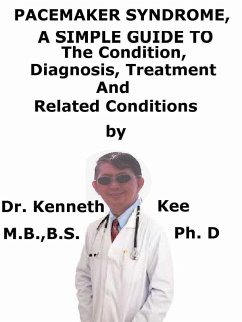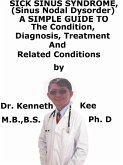Pacemaker syndrome is a group of symptoms related to the loss of AV synchrony (i.e. the atria contract at the same time as paced ventricular contractions) in patients with a pacemaker
The result is reduced cardiac output to which the total peripheral blood resistance will rise.
Not all patients show a rise in blood pressure and some will have a fall in their blood pressure.
A Pacemaker is an artificial device (implanted in the body under the skin) connected to the heart electrically to regulate the heart rate and rhythm.
There are patients with VVI pacemakers, mainly with sinoatrial (SA) rather than atrioventricular (AV) disease, who show reverse ventriculo-atrial (VA) conduction during ventricular pacing which can produce fatigue, dizziness and hypotension.
Pacemaker syndrome is linked with atrial cannon waves produced by simultaneous atrial and ventricular contractions.
Replacement with a dual chamber pacemaker (two leads placed in the right atrium and right ventricle) is needed.
Pacemaker syndrome is defined as:
1.Loss of AV synchrony.
2.Retrograde VA conduction.
3.Absence of rate response to physiological need
Generally, the symptoms of the syndrome are a combination of:
1.Reduced cardiac output,
2.Loss of atrial contribution to ventricular filling,
3.Loss of total peripheral resistance response, and
4.Non-physiologic pressure waves.
Persons with a low heart rate before pacemaker implantation are at higher risk of forming pacemaker syndrome.
Normally the first chamber of the heart (atrium) contracts while the second chamber (ventricle) is relaxed, permitting the ventricle to fill before it contracts and pumps blood out of the heart
When the timing between the 2 chambers is not synchronized, less blood is pumped on each beat.
Patients who have the pacemaker syndrome may need to adjust the pacemaker or fit of another lead to better coordinate the timing of atrial and ventricular contraction
Causes
The precise cause is not known.
In the pre-implantation period, there are two variablesthat predispose to the syndrome:
1.Low sinus rate,
2.Higher programmed lower rate limit
In the post-implantation period, a higher percentage of ventricular paced beats is the only variable that largely predicts development of pacemaker syndrome.
Patients with intact VA conduction are at higher danger for forming pacemaker syndrome
Symptoms and signs of heart failure may occur
Symptoms are pulsation and fullness in the neck, dizziness, palpitations, fatigue, light-headedness and syncope.
Signs are hypotension, tachycardia, tachypnea, raised JVP and cannon waves
Diagnosis
ECG: any sign of myocardial ischemia, arrhythmias or abnormal sensing
CXR can be done to identify the pacemaker
Pacemaker assessment:
Review triggering thresholds, lead impedance, and battery function.
Magnet application can produce asynchronous pacing mode and can show loss of capture and battery depletion
Treatment
In patients with other pacing types, other than ventricular pacing, symptoms normally recover after modifying and reprogramming of pacemaker parameters, such as:
1.Tuning the AV delay,
2.Changing the post-ventricular atrial refractory period, the sensing level, and pacing threshold voltage.
Hysteresis (pacing parameter allowing longer escape interval) reduces the quantity of time spent in pacing mode, thus relieving symptoms, mainly when the pacing mode is causing AV dyssynchrony.
If symptoms continue after all these treatment methods, replacing the pacemaker itself is sometimes beneficial and can relieve symptoms.
Symptoms recover after the change of the pacemaker to a dual-chamber pacing system.
TABLE OF CONTENT
Introduction
Chapter 1 Pacemaker Syndrome
Chapter 2 Causes
Chap...
Dieser Download kann aus rechtlichen Gründen nur mit Rechnungsadresse in A, B, CY, CZ, D, DK, EW, E, FIN, F, GR, H, IRL, I, LT, L, LR, M, NL, PL, P, R, S, SLO, SK ausgeliefert werden.









